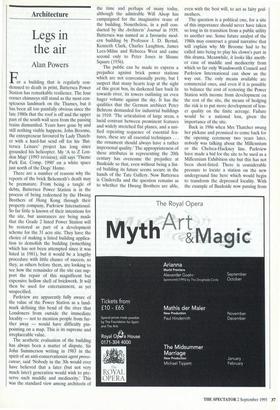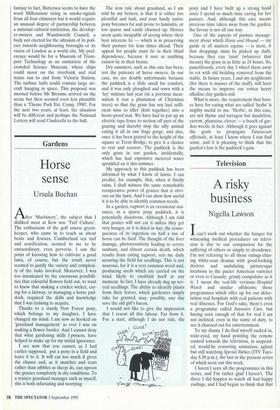Architecture
Legs in the air
Alan Powers
or a building that is regularly con- demned to death in print, Battersea Power Station has remarkable resilience. The four corner chimneys still stand as the most con- spicuous landmark on the Thames, but it has been all too painfully obvious since the late 1980s that the roof is off and the upper part of the south wall seen from the passing trains dismantled. Years have gone by and still nothing visible happens. John Broome, the entrepreneur favoured by Lady Thatch- er with a hard-hat send off for his 'Bat- tersea Leisure' project has long since grounded his helicopter. My 'A to Z Lon- don Map' (1993 revision), still says 'Theme Park Est. Comp. 1990' on a white space just north of the Dogs' Home.
There are a number of reasons why the reports of the brick Behemoth's death may be premature. From being a tangle of debts, Battersea Power Station is in the process of being redeemed by the Hwang Brothers of Hong Kong through their property company, Parkview International. So far little is known of their intentions for the site, but assurances are being made that the Grade 2 listed Power Station will be restored as part of a development scheme for the 31 acre site. They have the choice of making a listed building applica- tion to demolish the building (something which has not been attempted since it was listed in 1981), but it would be a lengthy procedure with little chance of success, so they, as others before them, are looking to see how the remainder of the site can sup- port the repair of this magnificent but expensive hollow shell of brickwork. It will then be used for entertainment, as yet unspecified.
Parkview are apparently fully aware of the value of the Power Station as a land- mark defining this bend of the river that Londoners from outside the immediate locality — not to mention people from fur- ther away — would have difficulty pin- pointing on a map. This is its supreme and irreplaceable value.
The aesthetic evaluation of the building has always been a matter of dispute. Sir John Summerson writing in 1983 in the spirit of an anti-conservationist agent provo- cateur, said 'Nobody in the 30s would ever have believed that a later (but not very much later) generation would wish to pre- serve such muddle and mediocrity.' This was the standard view among architects of the time and perhaps of many today, although the admirable Will Alsop has campaigned for the imaginative reuse of the building. Nonetheless, in a poll con- ducted by the Architects' Journal in 1939, Battersea was named as a favourite mod- ern building by Professor J. D. Bernal, Kenneth Clark, Charles Laughton, James Lees-Milne and Rebecca West and came second only to Peter Jones in Sloane Square (1936).
The public can be made to express a prejudice against brick power stations which are not conventionally pretty, but I suspect that many hearts leap at the sight of this great box, its darkened face back lit towards river, its towers outlining an even huger volume against the sky. It has the qualities that the German architect Peter Behrens demanded for industrial buildings in 1910: 'The articulation of large areas, a lucid contrast between prominent features and widely stretched flat planes, and a uni- fied repeating sequence of essential fea- tures, these are all essential techniques . . . the ornament should always have a rather impersonal quality.' The appropriateness of these attributes in representing the 20th century has overcome the prejudice at Bankside so that, even without being a list- ed building its future seems secure in the hands of the Tate Gallery. Now Battersea is Cinderella and the question remains as to whether the Hwang Brothers are able, even with the best will, to act as fairy god- mothers.
The question is a political one, for a site of this importance should never have taken so long in its transition from a public utility to another use. Some future analyst of the 1980s may construct a grand narrative that will explain why Mr Broome had to be called into being to play his clown's part in this drama. Meanwhile, it looks like anoth- er case of muddle and mediocrity from which so far only Wandsworth Council and Parkview International can show us the way out. The only means available are commercial ones, and even if it is possible to balance the cost of restoring the Power Station with income from development on the rest of the site, the means of hedging the risk is to put more development of less- er quality on the finite acreage. Failure would be a national loss, given the importance of the site.
Back in 1986 when Mrs Thatcher swung her pickaxe and promised to come back for the opening ceremony two years later, nobody was talking about the Millennium or the Chelsea-Hackney line. Parkview have made a bid for the site to be used as a Millennium Exhibition site but this has not been short-listed. There is considerable pressure to locate a station on the new underground line here which would begin to transform the depressed locality. With the example of Bankside now passing from fantasy to fact, Battersea seems to have the word Millennium rising in smoke-signals from all four chimneys but it would require an unusual degree of partnership between a national cultural institution, the develop- er-owners and Wandsworth Council, a body not elected for the altruism of its poli- cies towards neighbouring boroughs or its vision of London as a world city. My pref- erence would be for a Museum of Trans- port Technology as an outstation of the crowded Science Museum, where ships could moor on the riverbank and real trains run to and from Victoria Station. The turbine halls could contain large air- craft hanging in space. This proposal was mooted before Mr Broome arrived on the scene but then seemed even less plausible than a 'Theme Park Est. Comp. 1990'. For the next two years, at least, the situation will be different and perhaps the National Lottery will send Cinderella to the ball.



















































 Previous page
Previous page